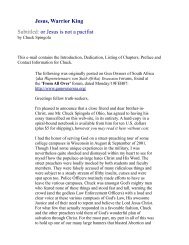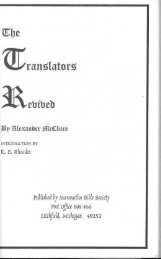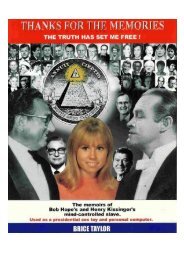THE PINK SWASTIKA - Shattering Denial
THE PINK SWASTIKA - Shattering Denial
THE PINK SWASTIKA - Shattering Denial
Create successful ePaper yourself
Turn your PDF publications into a flip-book with our unique Google optimized e-Paper software.
Indeed, homosexuality was all that qualified many of these men for their positions in the SA.<br />
Heinrich Himmler would later complain of this: “Does it not constitute a danger to the Nazi movement<br />
if it can be said that Nazi leaders are chosen for sexual reasons?” (Gallo:68). Himmler was not so much<br />
opposed to homosexuality itself as to the fact that non-qualified people were given high rank based on<br />
their homosexual relations with Roehm and others. For example, SA Obergruppenfuehrer (Lieutenant<br />
General) Karl Ernst, a militant homosexual, had been a hotel doorman and a waiter before joining the<br />
SA. “Karl Ernst is not yet thirty-five, writes Gallo, he commands 250,000 men...he is simply a sadist, a<br />
common thug, transformed into a responsible official” (ibid.:50f). Later, Ernst became a member of<br />
the German Parliament (Machtan:185). Gallo writes,<br />
Roehm, as the head of 2,500,000 Storm Troops had surrounded himself with a staff of perverts. His<br />
chiefs, men of rank of Gruppenfuehrer or Obergruppenfuehrer, commanding units of several hundred<br />
thousand Storm Troopers, were almost without exception homosexuals. Indeed, unless a Storm Troop<br />
officer were homosexual he had no chance of advancement” (Knickerbocker:55).<br />
Otto Friedrich’s analysis in Before the Deluge is similar:<br />
Under Rohm, the SA leadership acquired a rather special quality, however, for the crude and blustering<br />
Oberster SA Fuehrer was also a fervent homosexual, and he liked to surround himself, in all the<br />
positions of command, with men of similar persuasions (Friedrich:327).<br />
In the SA, the Hellenic ideal of masculine homosexual supremacy and militarism had finally been<br />
realized. “Theirs was a very masculine brand of homosexuality,” writes homosexualist historian Alfred<br />
Rowse, “they lived in a male world, without women, a world of camps and marching, rallies and sports.<br />
They had their own relaxations, and the Munich SA became notorious on account of them” (Rowse:<br />
214). The similarity of the SA to Friedlander’s and Brand’s dream of Hellenic revival is not<br />
coincidental. In addition to being a founder of the Nazi Party, Ernst Roehm was a leading member of<br />
the Society for Human Rights, an offshoot of the Community of the Elite (J. Katz:632).<br />
The relaxations to which Rowse refers in the above quote were, of course, the homosexual activities<br />
(many of them pederastic) for which the SA and the CE were both famous. Hohne writes,<br />
[Roehm] used the SA for ends other than the purely political. SA contact men kept their Chief of Staff<br />
supplied with suitable partners, and at the first sign of infidelity on the part of a Roehm favorite, he<br />
would be bludgeoned down by one of the SA mobile squads. The head pimp was a shop assistant<br />
named Peter Granninger, who had been one of Roehm’s partners...and was now given cover in the SA<br />
Intelligence Section. For a monthly salary of 200 marks he kept Roehm supplied with new friends, his<br />
main hunting ground being Geisela High School Munich; from this school he recruited no fewer than<br />
eleven boys, whom he first tried out and then took to Roehm (Hohne:82).<br />
Although the original SA chapter in Munich was the most notorious, other SA chapters were also<br />
centers of homosexual activity. In Political Violence and the Rise of Nazism, Richard Bessel notes that<br />
the Silesian division of the SA was a hotbed of perversion from 1931 onward (Bessel:61).<br />
Roehm and his closest SA associates were among the minority of Nazi homosexuals who did not<br />
take wives. Whether for convention, for procreation, or simply for covering up their sexual proclivities,<br />
most of the Nazi homosexuals had married. Some, like Reinhard Heydrich and Baldur von Schirach,<br />
married only after being involved in homosexual scandals, but often these men, who so hated<br />
femininity, maintained a facade of heterosexual respectability throughout their lives. As Machtan notes,<br />
“That Hitler...encouraged many of them to marry should not be surprising: every conspiracy requires<br />
camouflage” (Machtan:24). These were empty marriages, however, epitomized by one wife’s comment:<br />
“The only part of my husband I’m familiar with is his back” (Theweleit:3).<br />
As we have seen, then, the SA was in many respects a creation of Germany’s homosexual<br />
movement, just as the Nazi Party was in many ways a creation of the SA. Before we take a closer look









